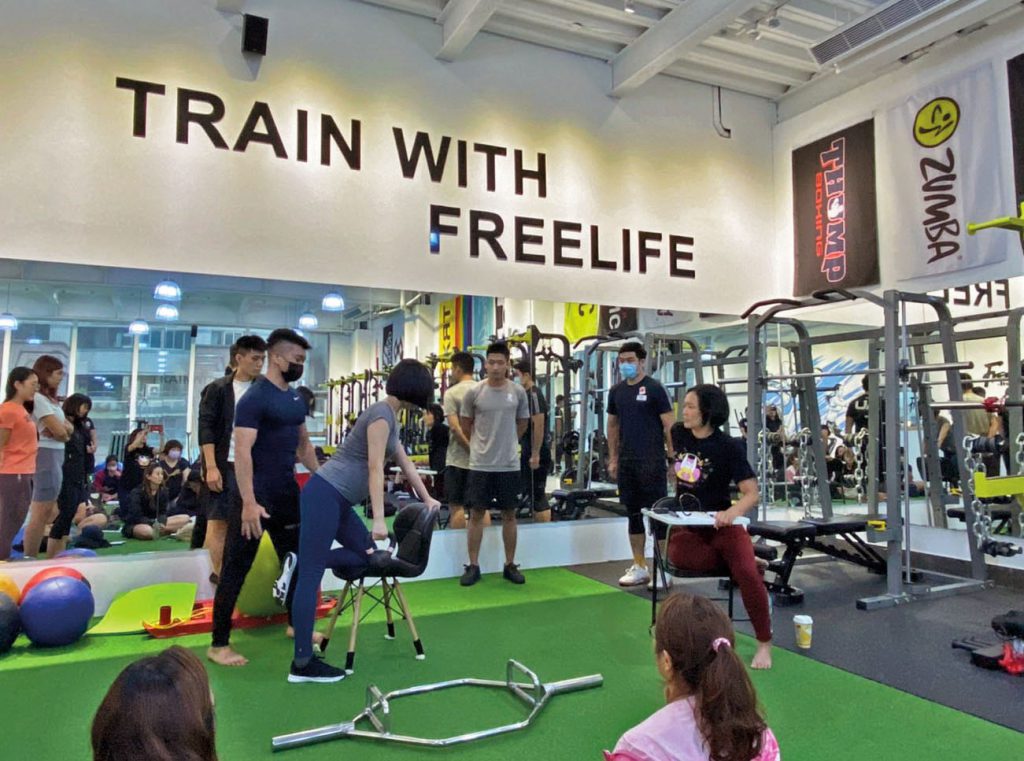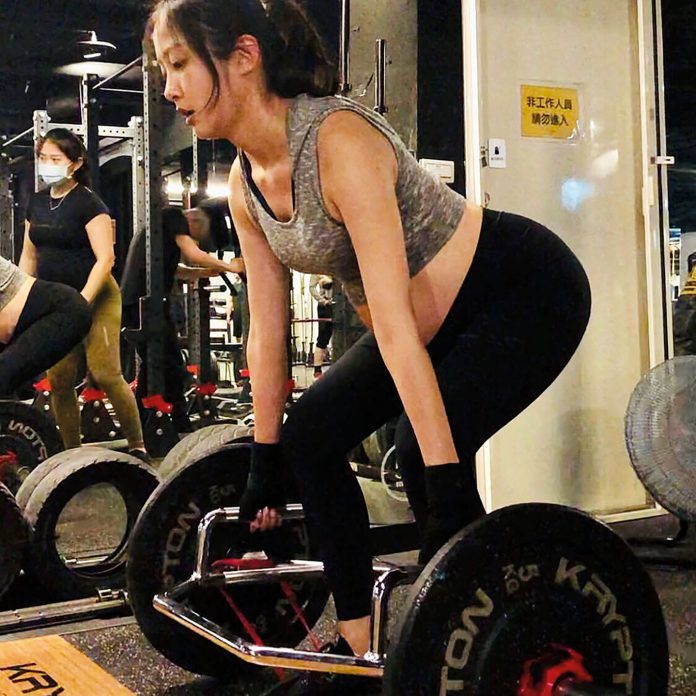Mothers find strength training beneficial for their pregnancy.
By Linn Wu in Taipei
Melissa Hsieh, a fashion designer, kept doing squats and deadlifts until the week she gave birth to her seven-pound baby boy in late August. The 31-year-old mother thanked the skills she learnt from her training for making her delivery quick and smooth.
“I only pushed about five rounds with 10 to 12 seconds for each round. My doctor and nurses praised me for making use of my body strength to push the baby out. They didn’t help me push at all,” Hsieh says. “[Giving birth on] an obstetric table is like performing Hatfield squats, which means you hold handles on each side and step on pedals. It’s almost the same.”

Though strength training has better prepared Hsieh for giving birth to her large-sized baby, her friends and family have different views on her workout during pregnancy.
“They want me to do moderate exercise such as yoga. Many people never train and they don’t understand. But my friends who also work out know that training is good for me. My husband supports me too,” she says.
Hsieh finds the concept of doing exercise during pregnancy alien to older generations. “The elderly usually think pregnant women should not carry heavy things and should avoid physical activities to keep babies safe. At first, I also thought lifting weights could hurt my baby. But I was soon corrected by my coach. She also did training during her own pregnancy,” she says.
Dr Wu, En-tzu, a 37-year-old obstetrician-gynaecologist, explains 80 per cent of miscarriages are due to abnormal embryos in early pregnancy. “Since there was no ultrasound in the old days, causes of miscarriages were unknown to most. It has nothing to do with doing exercise. If an embryo has no heartbeat, it will die eventually no matter what a mother does,” she says.
“Many factors can affect pregnancy. Some can be explained by science but some cannot. When doctors are uncertain, people make up something for the sake of seeking an explanation,” she adds.
Wu points out a mother’s body is gradually pulled forward during pregnancy as her baby grows. But most mothers do not know how to utilise their body strength and adapt to the change.
“They lack muscle strength. So it is easy to get hurt if they lift heavy objects. The problem here is not about whether pregnant women should lift heavy objects. The issue here is they should lift with the right movements,” she says.
“The problem here is not about whether pregnant women should lift heavy objects. The issue here is they should lift with the right movements.”
The Online Community
Wu started a private Facebook group in February. Lee Chia-hsin, a freelancer who is now eight months pregnant, is one of the group members.
“Medical consultation only lasts for about 15 minutes, including taking ultrasound pictures. But we have many questions to ask, such as questions about exercising during pregnancy. What kind of sports can pregnant women do? What kind of workout clothes suits us better? These are not big issues, but they do bother us,” Lee says.

The 36-year-old mother finds the Facebook community helpful and encouraging. “Even if a doctor assures that you can train, you still feel doubtful because you don’t see any real-life examples. But after seeing pictures of many pregnant women lifting heavy dumbbells or plates in the Facebook group, you believe it’s doable. Mothers will never risk hurting their babies,” she says.
Group members also find practical suggestions and knowledge about pregnancy that most doctors cannot provide. “Doctors do not study physical education and sports. They may not know details of sports that we want to do. But we can ask those who have experience in the group. Dr Wu, En-tzu also answers most of our questions as she has taken lessons about special training for pregnant women,” Lee says.
“Sometimes the group is more convincing than doctors’ advice, as you see examples in real life going through the same journey as I did. They are all normal people like you and me, so you believe you can do it too,” she says. The group has around 1,150 members as of early November.
The First Learner
Another member of the Facebook group, Jennifer Lin, 29, shares how she starts strength training. The first time mother started lifting sessions instead of jogging in the fifth month of her pregnancy. “Many pregnant women develop back pain and swelling, but I had neither of them during my pregnancy. I think my training helped. I didn’t use the support belt either,” she says.
In mid-September, Lin entered her 37th week of pregnancy, which is considered full-term. “Now I still train my core muscles and lower body. I feel good and plan to continue until I give birth,” she adds.

Two Babies, Different Experiences
Another mother, Catherine Chiou, stopped strength training when she had her first baby in 2017. “Not every medical staff knows pregnancy as well as an obstetrician. Their ideas are old-schooled,” the 32-year-old radiographer says.
She switched to light yoga in the second month after experiencing vomiting and vaginal bleeding, which are common in early pregnancy. “The elderly just ask you to sit. One tends to take extra care, as you don’t have any experience in your first pregnancy,” she says.
Her first baby belonged to the small-sized group, weighting less than four pounds at birth. When Chiou was pregnant again this year, she adjusted her diet and continued strength training at least three times a week. “All the problems during pregnancy were gone, such as gestational diabetes and urinary incontinence,” she says. Her second baby was born in early September and it weighed more than six pounds.
“My second baby came out in less than 10 minutes after I was on an obstetric table. Before the anaesthesia wore off, I felt energetic and posted myself on Facebook after giving birth. I also recovered faster this time. I went to the restroom by myself half a day after giving birth. Two weeks later, my belly was nearly back to normal shape,” she says.
Although Chiou recognised the benefits of lifting weights, she exercised secretly during her second pregnancy because people around her could not understand.
“I worked from 8 a.m. to 5 p.m. I rushed to the gym and trained for an hour during lunch break. My colleagues always questioned if I would [accidentally] squeeze my baby out earlier due to the heavy weights. But that’s not true,” she sighs.
According to British Journal of Obstetrics and Gynaecology in 2017, exercise can lower the risk of preterm birth by reducing oxidative stress or improving placental vascularisation.
The American College of Obstetricians and Gynaecologists in April, 2020 reported physical activity during pregnancy is safe and desirable. Pregnant women are encouraged to continue or to initiate safe exercise.
Wu suggests that mothers engage in both strength and aerobic exercise during pregnancy. Since pregnant women often have health problems such as dizziness and low blood sugar, they should avoid new challenges. Using up to 70 or 80 per cent of their maximum strength is preferred.
“If you encounter vaginal bleeding or suspected premature delivery, stop immediately and check with your doctor,” she adds.
Edited by Howard Li







































